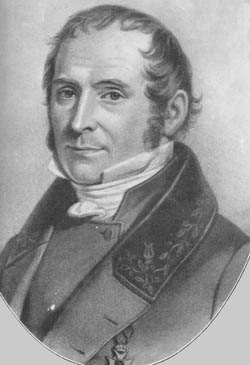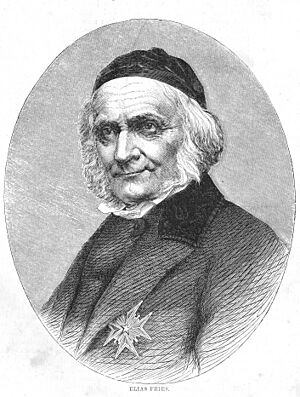Elias Magnus Fries facts for kids
Quick facts for kids
Elias Magnus Fries
|
|
|---|---|
 |
|
| Born | 15 August 1794 Femsjö, Hylte Municipality, Småland, Sweden
|
| Died | 8 February 1878 (aged 83) |
| Alma mater | Lund University |
| Known for | Founder of modern fungal taxonomy |
| Awards | Foreign Honorary Member of the American Academy of Arts and Sciences |
| Scientific career | |
| Fields | Mycology, Botany |
| Institutions | Lund University (1814–1834), Uppsala University (1834–1878) |
| Influences | Goethe |
| Author abbrev. (botany) | Fr. |
Elias Magnus Fries FRS FRSE FLS (born August 15, 1794 – died February 8, 1878) was a famous Swedish scientist. He studied mycology (the study of fungi) and botany (the study of plants). People sometimes call him the "Linnaeus of Mycology" because he was so important in classifying fungi. This is similar to how Carl Linnaeus classified plants and animals.
Contents
Elias Fries's Amazing Career
Early Life and Education
Elias Fries was born in a small Swedish village called Femsjö. His father was a pastor and taught him a lot about flowering plants. This early learning sparked his interest in nature.
In 1811, Elias went to Lund University. He earned his doctorate degree there in 1814. Soon after, he became an associate professor of botany.
Becoming a Professor
Elias Fries was very good at his work. He was elected as a member of the Royal Swedish Academy of Sciences. By 1824, he became a full professor at Lund University.
In 1834, he moved to Uppsala University. There, he became a professor of botany and applied economics. He was also chosen as a Foreign Honorary Member of the American Academy of Arts and Sciences in 1849. That same year, he became the director of the Uppsala University Botanical Garden. In 1853, he even became the head of the university, called the rector.
His Important Work with Fungi
Elias Fries wrote many important books about fungi. His most famous work was a three-volume series called Systema mycologicum (1821–1832). In these books, he described and classified many different types of fungi.
He is seen as one of the main founders of modern taxonomy for mushrooms. Taxonomy is the science of classifying living things. Fries was influenced by the famous writer Goethe.
Fries used special features to classify mushrooms. He looked at the color of their spores. He also studied how the hymenophore was arranged. The hymenophore is the part of the mushroom that produces spores, like the gills, pores, or teeth under the cap.
His Legacy
Elias Fries passed away in Uppsala on February 8, 1878. When he died, a newspaper called The Times said that his work on fungi and lichens was so important that it could only be compared to Carl Linnaeus's work. His contributions helped us understand the world of fungi much better.
Elias Fries's Family
Elias Fries had a son named Theodor Magnus Fries. Theodor also became a botanist. Elias's grandsons, Thore Christian Elias Fries and Robert Elias Fries, followed in their grandfather's footsteps and became botanists too.



